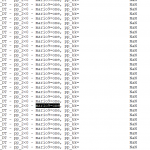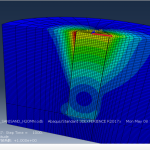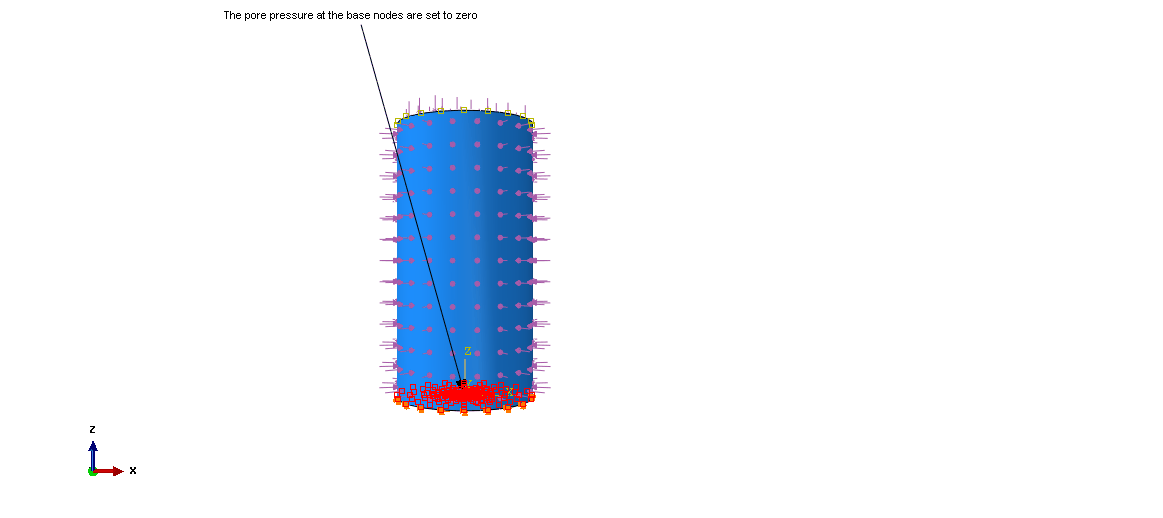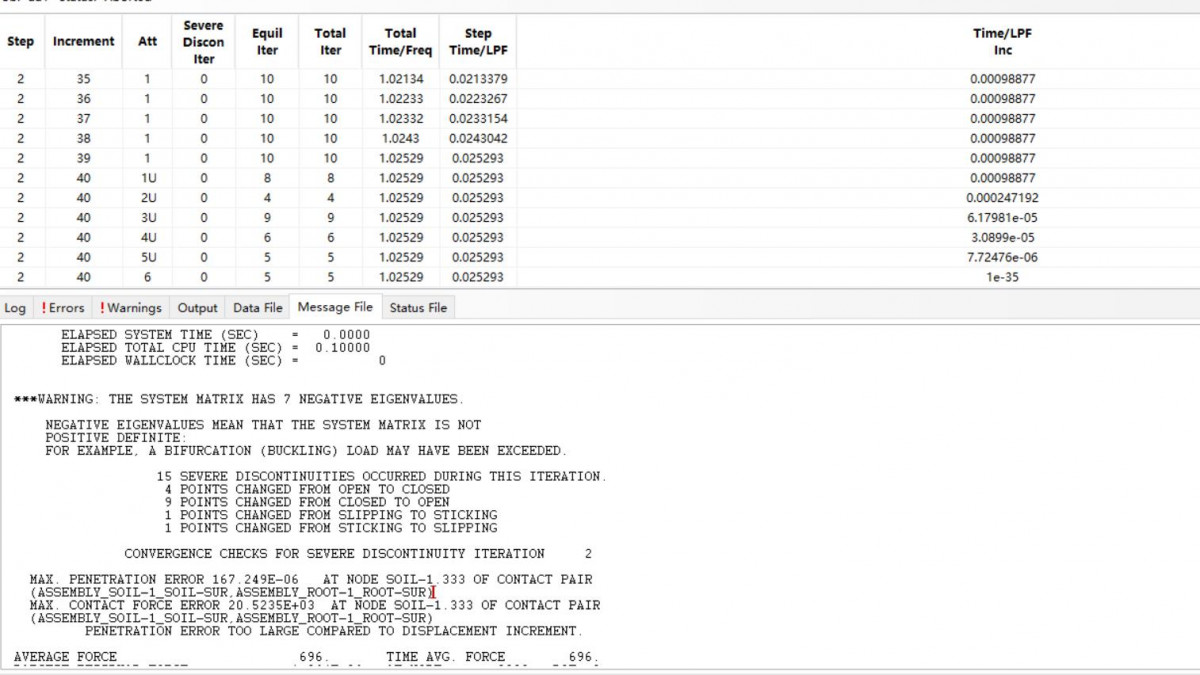Dear all
I was simulating a pile in a fully drained soil subjected to horizontal loads using ABAQUS (as shown in Figure 1) and noticed from the monitor that the calculation did not continue for a long time and when I interrupted the job I got a very large “.log” file (100-300g).
I have looked at the “.log” file and found that it is a repeated error message (as shown in figure 2), what is the meaning of this message and is there any way to avoid it?
Thank you in advance for your help!
An error in the SANISAND umat runtime
Related Articles
-
Modeling of triaxial test sample by using hypoplastic subroutine
 Naif Alsanabani||Finite Elements|7 |Views 3,969
Naif Alsanabani||Finite Elements|7 |Views 3,969
I tried to model sample of triaxial test in Abaqus program. I used hypoplastic subroutine. The parameters used in hypoplastic model was Hochstetten sand the given in website “https://web.natur.cuni.cz/uhigug/masin/plaxumat/node5.html”. The […] -
UMAT code for Unsaturated soil modes
 Arghya Das||Finite Elements|1 |Views 4,106
Arghya Das||Finite Elements|1 |Views 4,106
Hello Everyone, I am trying to implement an unsaturated soil model (BBM or similar) in ABAQUS using UMAT. We want to assign a pore-pressure boundary condition for simulating the drying […] -
Hypoplastic model for thermal cycles (Abaqus)
Chiara Iodice||Finite Elements|2 |
Views 3,605
Dear all, I’m using the UMAT file in which the hypoplastic model for thermal cycles is implemented. In the Abaqus input file I have added the two lines necessary to […] -
A problem of convergence from using Hypoplastic model in Abaqus
 Joe Chu||Finite Elements|5 |Views 3,660
Joe Chu||Finite Elements|5 |Views 3,660
Dear all, The sand hypoplastic model has been used to simulate the interaction between soil and pile. However, there is a bad convergence in the process of calculation. When I […] -
Modeling of granular soil by using UMAT hypoplastic in Abaqus
 Naif Alsanabani||Finite Elements|5 |Views 4,029
Naif Alsanabani||Finite Elements|5 |Views 4,029
Dear all I am using the UMAT of hypoplastic model for simulation soil (3D modeling) under cyclic loading. The analysis was completed at geostatic step. But for consolidation step (soil, […] -
ABAQUS-UMAT Help
 Mehmet Gocmez||Finite Elements|2 |Views 708
Mehmet Gocmez||Finite Elements|2 |Views 708
Hi everyone, I would like to ask if anyone has an example umat file for me to study to work on my master thesis researches. I would like to create […] -
Special issue of Computers and Structures “Numerical simulation of multi‐physics phenomena in geotechnical structures”
 David Mašín||Finite Elements|1 |Views 5,678
David Mašín||Finite Elements|1 |Views 5,678
https://www.sciencedirect.com/journal/computers-and-structures/about/forthcoming-special-issues Numerical simulation of multi‐physics phenomena in geotechnical structures Complete and thorough analysis of geotechnical structures, requires various complex materials models with internal structures, which cannot be described by the […] -
DIANA 10.5 new features
 jesus mediavilla||Finite Elements|0 |Views 4,170
jesus mediavilla||Finite Elements|0 |Views 4,170
DIANA 10.5 was released in 2021. It features many powerful capabilities to model soil-structure interection. See more in https://dianafea.com/2021-DIANA10-5-Release
Who is Online
No one is online right now
Search SoilModels Website
Recent posts
-
 Degradation ( disturbance ) of hypoplastic clay 23.4.2024
Degradation ( disturbance ) of hypoplastic clay 23.4.2024
-
 Degradation ( disturbance ) of hypoplastic clay 23.4.2024
Degradation ( disturbance ) of hypoplastic clay 23.4.2024
-
 Paper of Coulomb, C. A. (1773) 15.4.2024
Paper of Coulomb, C. A. (1773) 15.4.2024
-
 ABAQUS UMAT of hypoplastic clay model 6.4.2024
ABAQUS UMAT of hypoplastic clay model 6.4.2024
-
 Prague Geotechnical Days 2024 “Geotechnical monitoring” and 30th jubilee Prague Geotechnical Lecture by prof. Eduardo Alonso 5.4.2024
Prague Geotechnical Days 2024 “Geotechnical monitoring” and 30th jubilee Prague Geotechnical Lecture by prof. Eduardo Alonso 5.4.2024
-
 UMAT for Creep-SCLAY model. 1.3.2024
UMAT for Creep-SCLAY model. 1.3.2024
-
 Cyclic tests with Triax element test driver 14.2.2024
Cyclic tests with Triax element test driver 14.2.2024
-
 SUMMER SCHOOL ‘Numerical Modelling in Geotechnical Engineering’, Innsbruck – July 22nd-26th, 2024 1.2.2024
SUMMER SCHOOL ‘Numerical Modelling in Geotechnical Engineering’, Innsbruck – July 22nd-26th, 2024 1.2.2024
-
 COURSE IN SOIL MODELING – NTNU, Trondheim – October 14th to 18th, 2024 21.12.2023
COURSE IN SOIL MODELING – NTNU, Trondheim – October 14th to 18th, 2024 21.12.2023
-
 MSE walls design in Plaxis 11.12.2023
MSE walls design in Plaxis 11.12.2023
-
 sand liquefaction modelling in Anura3D 8.12.2023
sand liquefaction modelling in Anura3D 8.12.2023
-
 BCV bentonite experimental and modelling datasets 14.11.2023
BCV bentonite experimental and modelling datasets 14.11.2023
Recent Comments
- Zhentao Liu on Problem in simulating CPT using SANISAND04
- Gertraud Medicus on ABAQUS UMAT of hypoplastic clay model
- Chen Zhiming on Download Package of Charles University Implementation of High Cycle Accumulation Model
- Konstantinos Chatzis on Cyclic tests with Triax element test driver
- Abhay Pratap Singh on Cyclic tests with Triax element test driver
- Giovanni Ciardi on Cyclic tests with Triax element test driver
- Konstantinos Chatzis on Cyclic tests with Triax element test driver
- Ismail Khan on Cyclic tests with Triax element test driver
- Kanika Lamba on Cyclic tests with Triax element test driver
- Arie Koot on How to model the settlement in soil due to water drawdown.
- Konstantinos Chatzis on Cyclic tests with Triax element test driver
- Jose Duque on Cyclic tests with Triax element test driver
- MohamadReza Kamali on How to model the settlement in soil due to water drawdown.
- Leo Alibert on MSE walls design in Plaxis
- Ignacio Zuloaga on MSE walls design in Plaxis
- Giada Orlando on Problem with VUMAT interface
- Michael Spyridis on Problem with VUMAT interface
- Ahmad Moeineddin on Problem with VUMAT interface







Sorry I got the order of the pictures wrong. Figure 1 is the “.log” file that reported the error, and Figure 2 is the piled soil model
substepsize is too low < 1e-18
problem cannot been solved.
perhaps model is wrong
Dear Arie:
Thank you so much for helping again! Does this error mean that the analysis step is too small?
I’m curious why my ABAQUS doesn’t break the calculation but keeps repeating the attempt
It do not know which units you have used, but if the displacement is in meters the displacement is large (20cm), and it lookes there is a gab between pile and soil. IF you have used fully drained and cohesion is zero this is unstable and because you have used an implicit methode it probably not converts. Try to increase cohesion (p-shift).
The units in the simulation are m. I am simulating the horizontal displacement of a pile in a sandy soil.
Shouldn’t the cohesion c=0 and parm18 be taken as 0 for sand?
Also, is 20cm a large displacement? I have seen in many papers that the horizontal displacement of the mud surface in the simulation results reaches D/10, for my simulation (pile diameter D=10m) this displacement should reach 1m.
Thanks again for your reply!!!
To add to this, the monitor shows that the incremental step size is not reduced, it stays at the maximum step size I set, but no further calculations are performed, just the machine idles (100% CPU usage) while generating a large LOG file.
If convergence is a problem, ABAQUS should show 1U,2U… Until the calculation breaks isn’t it?
Why does ABAQUS not show 1U.2U etc. after calling SANISAND’s UMAT, but stays at one analysis step and repeats the LOG file writing?
I’m running a full drained simulation, i.e. can’t c take 0 in the case of full drained?
There is tension in the soil: because c=0 it is not possible.
DT_k is reduced to DTmin and DTMin is very low.
Send .inp, .cae, .for in a zip-file to koot@zonneveld.com and I can see.
else
c … if pp_2 lower than zero
DT_k=DT_k/four
if(DT_k.lt.DTmin) then
DT_k= one – T_k
mario_DT_test=1
write(*,*) ‘mario_DT – pp_2<0 – mario9=one, pp_kk=',pp_kk
end if
endif
c
Dear Arie
Thank you very much! I’ve noticed what this code does.
After reading your reply yesterday, I set parm18=0.1 and ran the simulation again, but the simulation did not achieve the target of 1m horizontal displacement of the mud surface either.
I have send my .inp, .cae and .for to your email, Thank you in advance for your help!
use dynamic implicit instead of static general for displacement
take 1 step after gravity.
time for example 100sec and minimal increment 1 sec
Thank you for your advice! I have tried to replace the steps from static to dynamic implicit. However, after the geostress step is completed, ABAQUS begins to idle rather than continue the dynamic implicit step.
The error is still the same as the Fig.1 in my original post.
I am now looking for which step of the UMAT run will cause pp _ kk to become NAN.
geostep is not correct: only soil stresses are calculated: state var are zero (included void)
for geostep you need umat or sigini+sdvini
if you use umat some code have to be added to add stresses to avoid lot of vertical displacement.
But it will not solve your problem that model gives umat-rrors and not convert.
Thank you for reply, Arie! I will correct GeoStep with the guide of your advice. As for the errors, I am still looking for the code causing this bug. There is no division operation in the calculation of PP_KK, I don’t think the result of it could get the result of NAN. If you know, can you tell me what other cases would cause PP_KK=(SIG1+SIG2+SIG3)/3 to be calculated to get the answer of NAN?
Just a general question: Why you want to use sanisand umat?
I am study in the direction of constitutive models. And SANISAND model is the first sand model that I have been exposed. Since its code is easily available (posted on this website), I chose this model as the first step in learning the constitutive model.